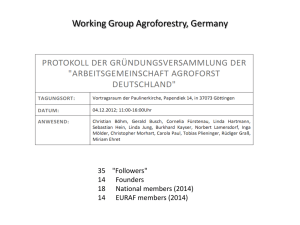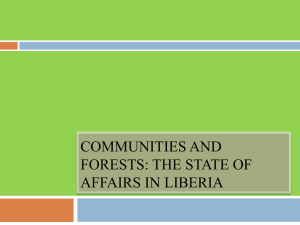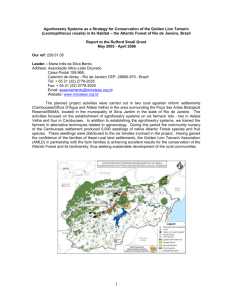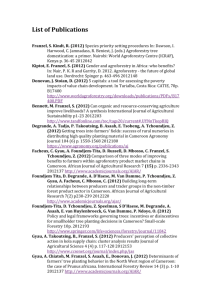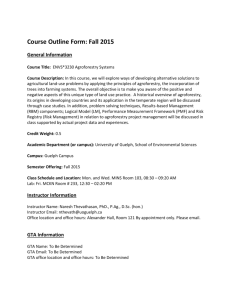Business Transcription Services Voxtab
advertisement
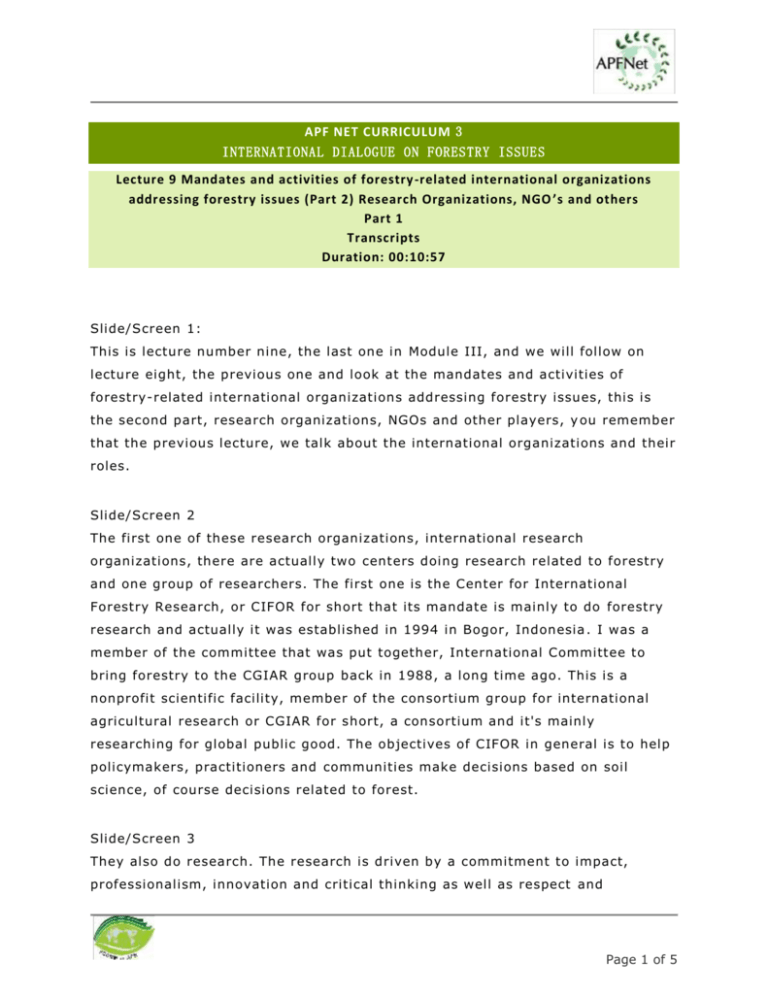
APF NET CURRICULUM 3 INTERNATIONAL DIALOG UE ON FORESTRY ISSUES Lecture 9 Mandates and activities of forestry -related international organizations addressing forestry issues (Part 2) Research Organizations, NGO ’s and others Part 1 Transcripts Duration: 00:10:57 Slide/Screen 1: This is lecture number nine, the last one in Module III, and we will follow on lecture eight, the previous one and look at the mandates and activities of forestry-related international organizations addressing forestry issues, this is the second part, research organizations, NGOs and other players, y ou remember that the previous lecture, we talk about the international organizations and their roles. Slide/Screen 2 The first one of these research organizations, international research organizations, there are actually two centers doing research related to forestry and one group of researchers. The first one is the Center for International Forestry Research, or CIFOR for short that its mandate is mainly to do forestry research and actually it was established in 1994 in Bogor, Indonesia . I was a member of the committee that was put together, International Committee to bring forestry to the CGIAR group back in 1988, a long time ago. This is a nonprofit scientific facility, member of the consortium group for international agricultural research or CGIAR for short, a consortium and it's mainly researching for global public good. The objectives of CIFOR in general is to help policymakers, practitioners and communities make decisions based on soil science, of course decisions related to forest. Slide/Screen 3 They also do research. The research is driven by a commitment to impact, professionalism, innovation and critical thinking as well as respect and Page 1 of 5 collaboration, these are the kind of guiding principles for CIFOR research, research to have impact, it is not r esearching just to be put on the shelves, it must have an impact, that's why impact assessment is very important to CIFOR activities. And I'm quite familiar with the work of CIFOR as the chair of the board of trustees until the end of December, 2014. So lo ok at those research that support professionalism, it's a very professional research, innovative or something new, critical thinking, also part of the activity it's not only just all the research, it must be some critical thinking there, which is based on respect for all researchers, all countries, regarding rich and poor, developed or developing, and collaboration. As I said its headquarter is in Bogor, Indonesia with offices in eight different countries across Asia, Latin America and Africa and projects i n more than 30 countries around the world, mainly in the tropics, I should say. Slide/Screen 4 Its latest strategy 2008-2018, the idea is to make a difference for forests and people. It's under revision now to be developed a new strategy. The priority research in the existing or the current strategy that are in priority research, enhancing the role of forests in climate mitigation, that's very important add to this, that is part of the work related to climate change , enhancing the role of forests in adaptation to climate change, I described this before, mitigation means trying to reduce the harmful effect of greenhouse gas emission by reducing the emission itself, adaptation needs to have the ecosystem from plants and animals, forests, people adapted to climate change. Third priority is improving the livelihoods through smallholder and community forestry. Managing tradeoffs between conservation and development at landscape scale, that's very important because there must be some tradeoffs either you close the forest and go home, it doesn't work, that's not conservation, but conservation in the traditional way understood that there is a balance between conservation and development. And the fifth priority is managing impacts of globalised trade and investmen t on forests and forest communities. It's a lot of, you know forest is a global issue, the trade is also global. There is a global trade in forest and they look at impact on forests and communities. And finally, priority research is sustainable management of tropical production forests. Not this year that there is a lot of interests in production. It's not only, you know Page 2 of 5 conservation, conservation is very important but also there is economic use of the forest. Slide/Screen 5 Second center, part also of the CGIAR family is ICRAF or it used to, now it's called World Agroforestry Center, it used to be ICRAF, International Center for Research in Agroforestry, but now it is changing the name a few years back to World Agroforestry Center. It focuses on researc h associated with or associated to agroforestry. Agroforestry is simply the system that combines agriculture and forest, whether it's in space or in time, whether it is agriculture co -production and forest replanting, animal production whatever, it's a com bination of that all. The headquarters is in Nairobi, Kenya with five regional offices in Cameroon, India, Indonesia, Kenya and Peru. Slide/Screen 6 There are six domains or six research areas in CIFOR currently. First one is domestication, utilization and conservation of superior agroforestry germplasm. This domain looks at the germplasm, species, varieties, cultivars, ecotypes, subspecies, whatever the entity that has a potential for agroforestry, in the wild they will call domestication, utilization and conservation, just after testing it's a germplasm. Second domain or research area is maximizing the productivity of agroforestry systems, and I said there are several systems, combining coproduction with trees and reproduction of trees, protection with tr ees and so on. The third domain is improving marketing and extension services for smallholders, related to agroforestry protection. Fourth is the enhancing of land productivity and food availability, that's very much related to agriculture but under an agroforestry system, Then they are looking at climate change adaptation, again as climate change, as agroforestry systems, and this is getting to be a little bit more complicated because you are looking at the adaptation of trees and agriculture production under climate change and then finally the development of policies for multi -functional landscapes and environmental services provision, ES stands for environmental services. That's also looking at, by nature the agroforestry system is a multi -functional syst em. You are looking at the multi -functional landscapes and I will describe the landscape in details in the last lecture. Page 3 of 5 Slide/Screen 7 Then there is the group of international bodies working on forestry research, or related to forestry research . They are all organized under one union, or organization called the International Union for Forest Research Organizations. That's a global network. It's a network, it's not an institution by itself, it's a network of forest science and for cooperation, forest scien ce cooperation network, you can put it in this way. But it's a global one. IUFRO or international union of forest research organizations unites more than 15,000 scientists from 700 member organizations in over 110 countries. This is the oldest union of forestry in the world. It's more than 110, 120 years now. I think 125 years or so. It's established in Europe, in Germany, Austria and it's all over the world, 110 countries, 15,000 scientists you know under one umbrella, that's a huge resource. Slide/Screen 8 The vision of the union or this organization is to serve the needs of all forest researchers and decision makers, that's very important, it's not only researchers but they're trying to cater for the inter-relationship between researchers and forestry and policymakers, and its mission three parts, one to promote global cooperation in forest -related research, just promote cooperation, bringing scientists together in meetings and cooperation; enhance understanding of th e ecological, economic and social aspects of trees, that is also part of the mission, supporting the research activities in this direction and it has also a mission in disseminating scientific knowledge to contribute to forest policy and forest management, that's very important, th at's very much needed. You know you have 15,000 sites related to forest, working on subjects related to forest, and there's no connection between them except under this union. Or there may be some individuals, bilateral, multilateral, but to bring all these together is a very very important task and IUFRO is playing a very significant role in simulating the information, extracting it from most of these research, not only to forest scientists but trying to disseminate this information to the policymakers and forest management. Slide/Screen 9 Page 4 of 5 [End of Module III, Lecture 9, Part 1] Page 5 of 5






